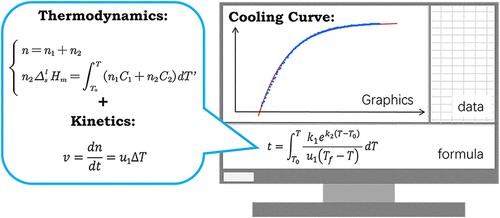Mathematical Modeling of Cooling Curve of One Component Phase Transition System
IF 2.9
3区 教育学
Q2 CHEMISTRY, MULTIDISCIPLINARY
引用次数: 0
Abstract
Cooling curves of melts provide a wealth of information regarding latent heat, heat transfer, the Gibbs phase rule, and mass transfer kinetics during phase transition. In this study, a computer-based activity was designed to deepen upper-level undergraduate students’ comprehension of the intricate phase transition process. This activity primarily employs mathematical modeling methods based on conservation of energy and crystallization kinetic equations to derive a mathematical relationship between temperature and time during the supercooling phase transition of a single-component metal. Mathematics teaching software GeoGebra was utilized for graphing and comparing the derived mathematic model with experimental data. Following the activity, students’ learning outcomes were evaluated using a questionnaire. The average score was 86.87 for the first round of students and 88.26 for the second round of students. Incorporating mathematical modeling of cooling curves into physical chemistry laboratory teaching has resulted in noticeable enhancement in the student’s learning. Overall, this activity effectively enhanced students’ comprehension of mathematical modeling, computational skills, and problem solving skills. The activity significantly enriches students’ comprehensive understanding of cooling curves and associated experiments in physical chemistry.

单组分相变系统冷却曲线的数学建模
熔体的冷却曲线提供了大量有关相变过程中潜热、传热、吉布斯相法则和传质动力学的信息。本研究设计了一个基于计算机的活动,以加深高年级本科生对错综复杂的相变过程的理解。该活动主要采用基于能量守恒和结晶动力学方程的数学建模方法,推导单组分金属过冷相变过程中温度和时间之间的数学关系。数学教学软件 GeoGebra 用于绘制图表,并将得出的数学模型与实验数据进行比较。活动结束后,使用问卷对学生的学习成果进行了评估。第一轮学生的平均得分为 86.87 分,第二轮学生的平均得分为 88.26 分。在物理化学实验教学中加入冷却曲线的数学建模,明显提高了学生的学习效果。总体而言,该活动有效地提高了学生对数学建模的理解能力、计算能力和解决问题的能力。该活动极大地丰富了学生对冷却曲线和物理化学相关实验的全面理解。
本文章由计算机程序翻译,如有差异,请以英文原文为准。
求助全文
约1分钟内获得全文
求助全文
来源期刊

Journal of Chemical Education
化学-化学综合
CiteScore
5.60
自引率
50.00%
发文量
465
审稿时长
6.5 months
期刊介绍:
The Journal of Chemical Education is the official journal of the Division of Chemical Education of the American Chemical Society, co-published with the American Chemical Society Publications Division. Launched in 1924, the Journal of Chemical Education is the world’s premier chemical education journal. The Journal publishes peer-reviewed articles and related information as a resource to those in the field of chemical education and to those institutions that serve them. JCE typically addresses chemical content, activities, laboratory experiments, instructional methods, and pedagogies. The Journal serves as a means of communication among people across the world who are interested in the teaching and learning of chemistry. This includes instructors of chemistry from middle school through graduate school, professional staff who support these teaching activities, as well as some scientists in commerce, industry, and government.
 求助内容:
求助内容: 应助结果提醒方式:
应助结果提醒方式:


